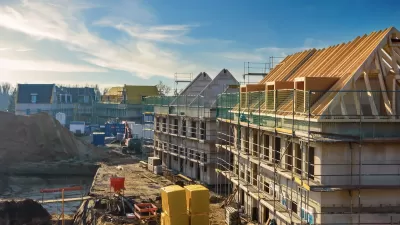Steven Pearlstein reads the tea leaves to predict the future development patterns in Washington, D.C. and finds that all signs point inwards to the city center and its closer-in suburbs.
As Pearlstein writes in The Washington Post its not just anti-sprawl activists and smart-growth planners who are trumpeting the call towards infill development, most developers he's spoken to agree.
Pearlstein sees a correlation between the abandonment of the traditional enclosed shopping mall and suburban office park, both representing major shifts in the economics of housing and commercial development. Demographic shifts, changing tastes and the damage wrought by the economic downturn will mean continued bad news for the outer suburbs and exurbs. Whereas, the market has remained strong and will continue to grow in the District and its inner suburbs.
"There are natural limits to how much a metropolitan region can expand its economy and its population by expanding its geographic footprint, and Washington is probably getting pretty close to them. The evidence can be found in the horrible commutes, in the divergent trends in land values at the core and at the periphery, and in the extraordinary cost of extending Metrorail to Loudoun County."
To successfully accommodate these shifts will take good, determined planning and "political and business leadership to accommodate, accelerate and manage that process."
FULL STORY: Steven Pearlstein: For development, all signs point inward

Alabama: Trump Terminates Settlements for Black Communities Harmed By Raw Sewage
Trump deemed the landmark civil rights agreement “illegal DEI and environmental justice policy.”

Study: Maui’s Plan to Convert Vacation Rentals to Long-Term Housing Could Cause Nearly $1 Billion Economic Loss
The plan would reduce visitor accommodation by 25% resulting in 1,900 jobs lost.

Why Should We Subsidize Public Transportation?
Many public transit agencies face financial stress due to rising costs, declining fare revenue, and declining subsidies. Transit advocates must provide a strong business case for increasing public transit funding.

Paris Bike Boom Leads to Steep Drop in Air Pollution
The French city’s air quality has improved dramatically in the past 20 years, coinciding with a growth in cycling.

Why Housing Costs More to Build in California Than in Texas
Hard costs like labor and materials combined with ‘soft’ costs such as permitting make building in the San Francisco Bay Area almost three times as costly as in Texas cities.

San Diego County Sees a Rise in Urban Coyotes
San Diego County experiences a rise in urban coyotes, as sightings become prevalent throughout its urban neighbourhoods and surrounding areas.
Urban Design for Planners 1: Software Tools
This six-course series explores essential urban design concepts using open source software and equips planners with the tools they need to participate fully in the urban design process.
Planning for Universal Design
Learn the tools for implementing Universal Design in planning regulations.
Smith Gee Studio
Alamo Area Metropolitan Planning Organization
City of Santa Clarita
Institute for Housing and Urban Development Studies (IHS)
City of Grandview
Harvard GSD Executive Education
Toledo-Lucas County Plan Commissions
Salt Lake City
NYU Wagner Graduate School of Public Service




























